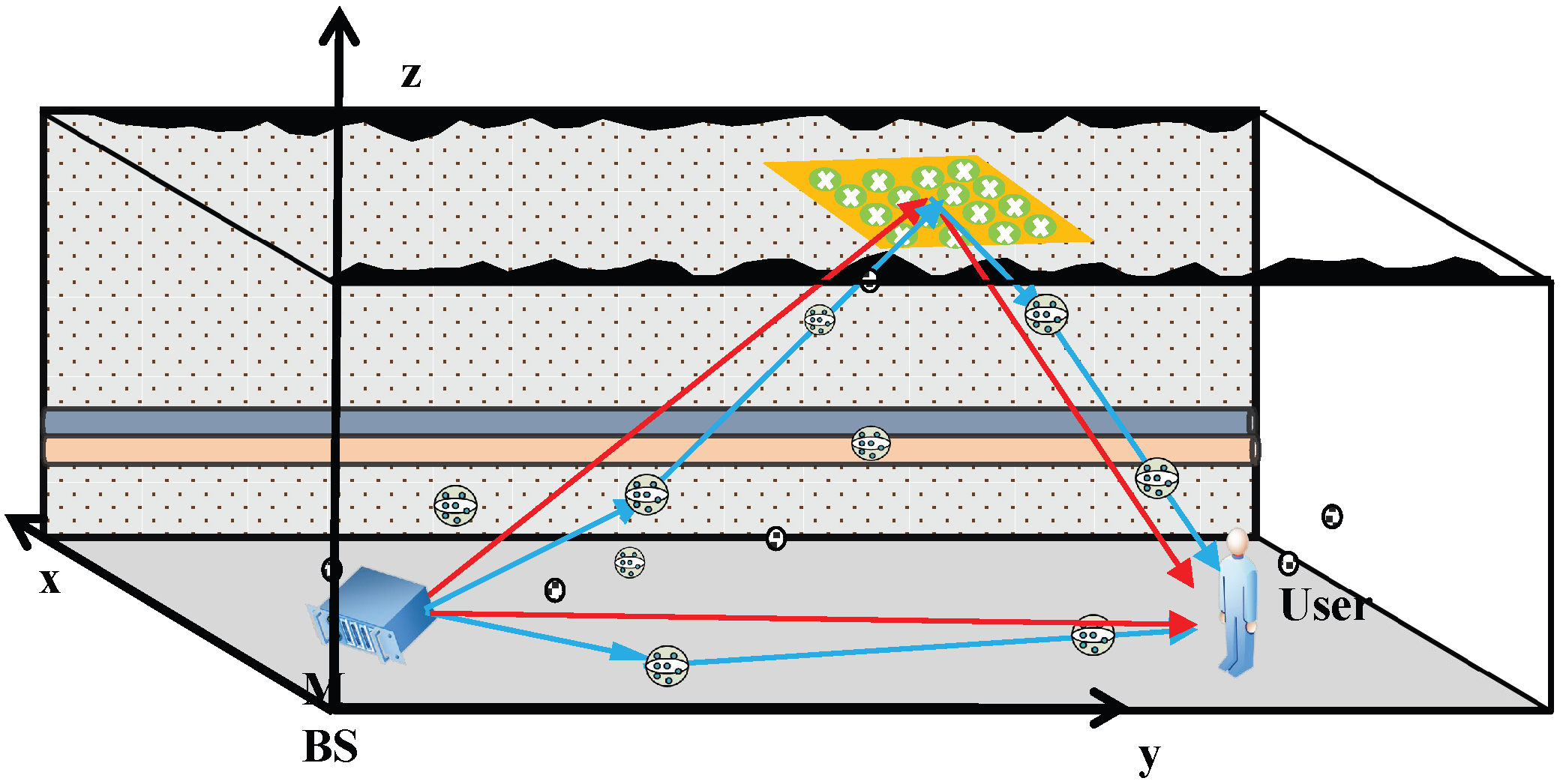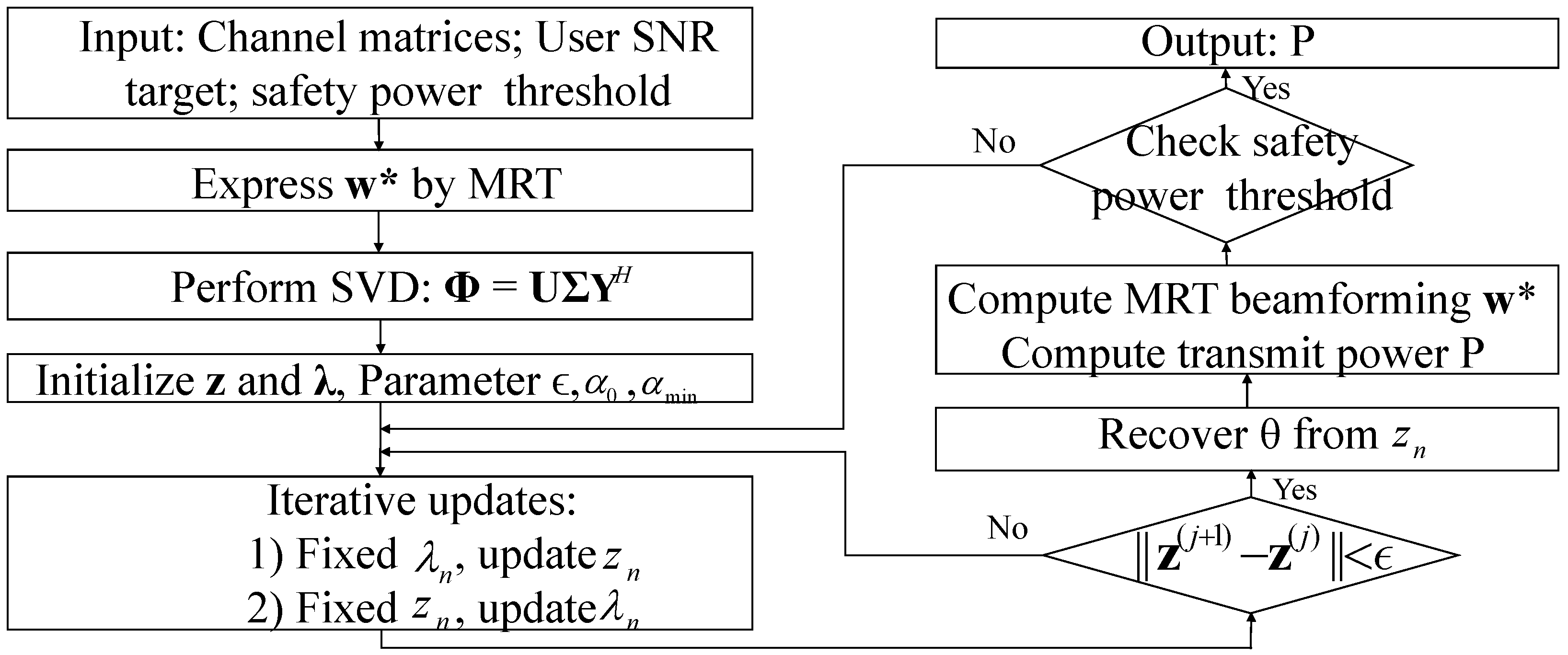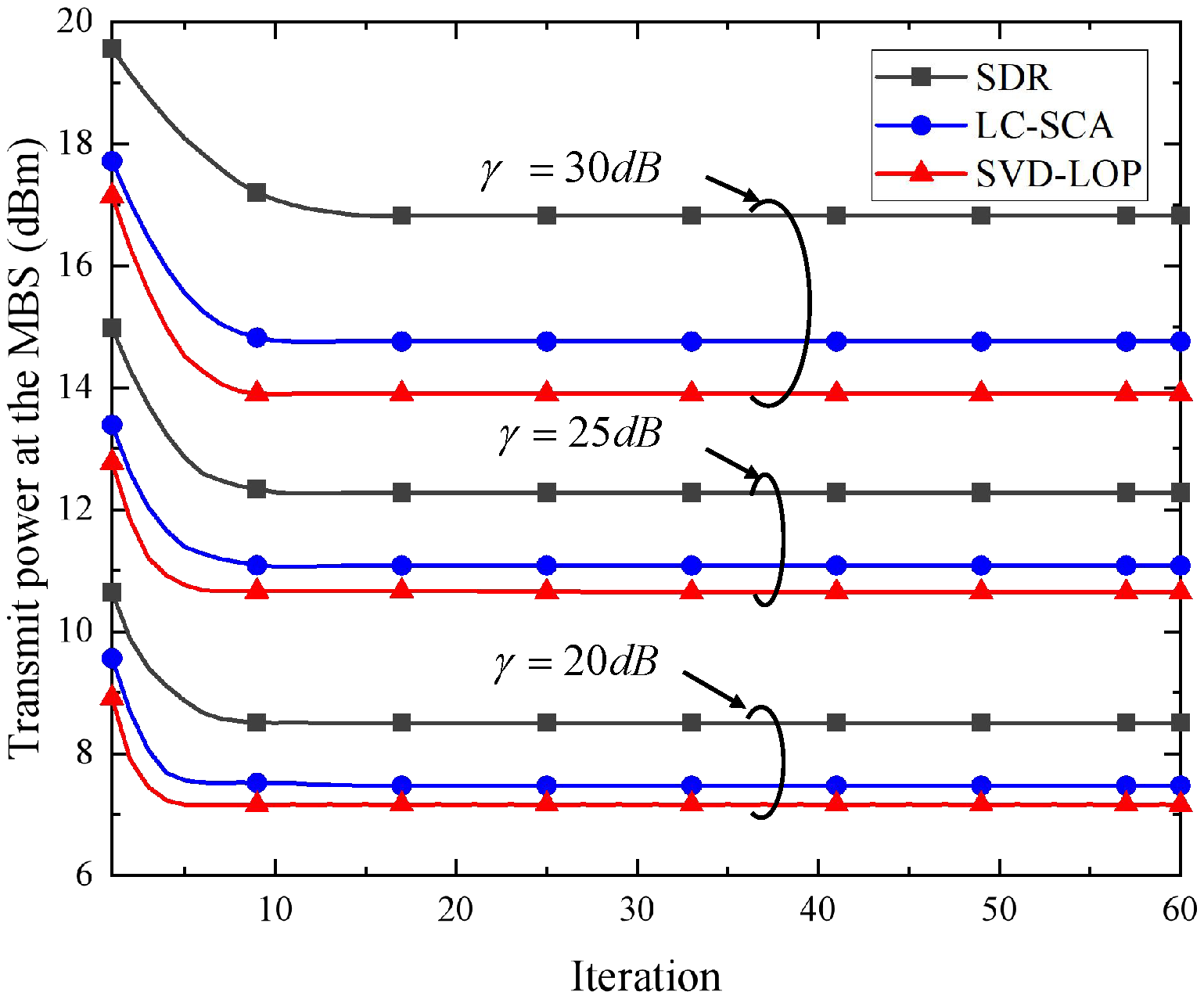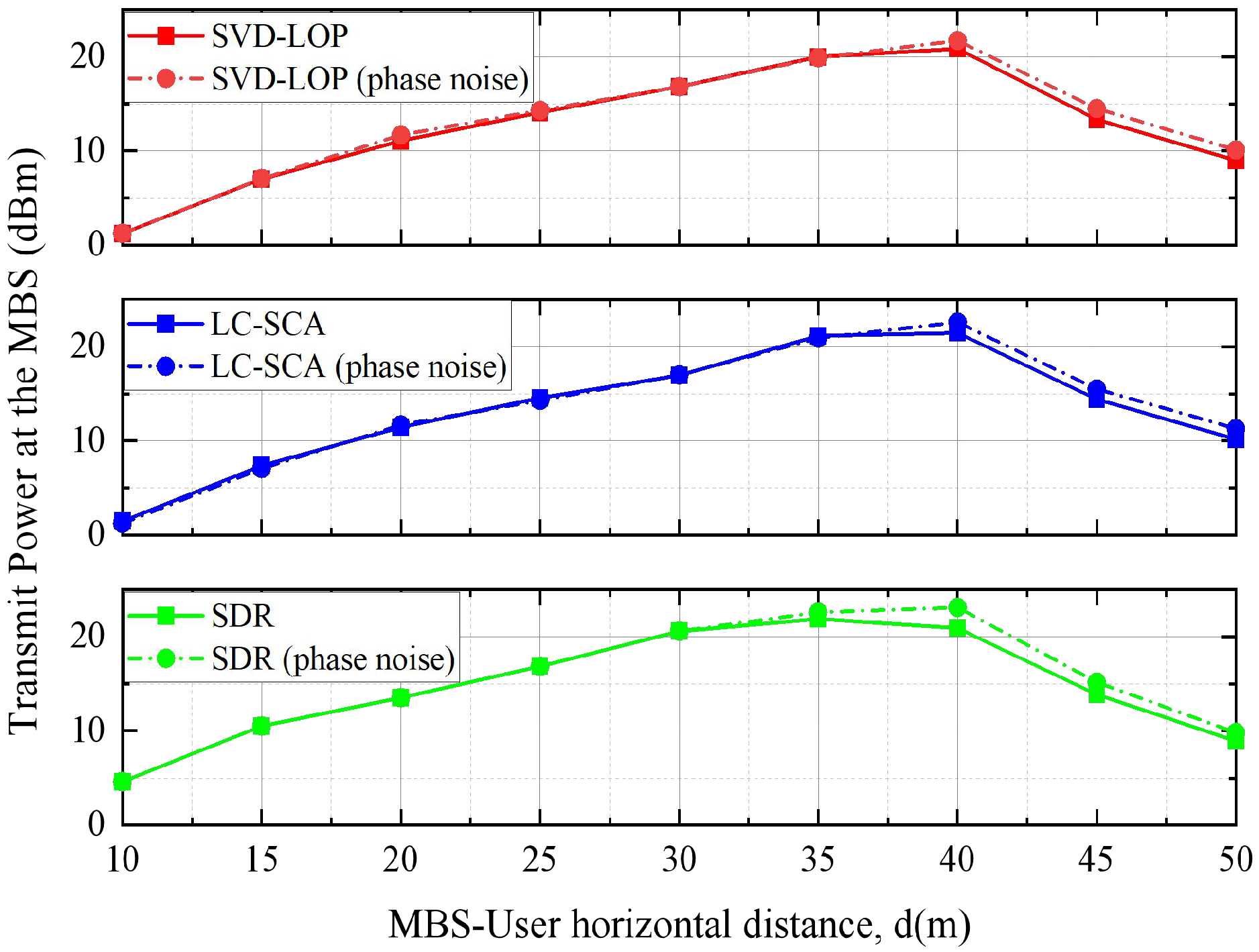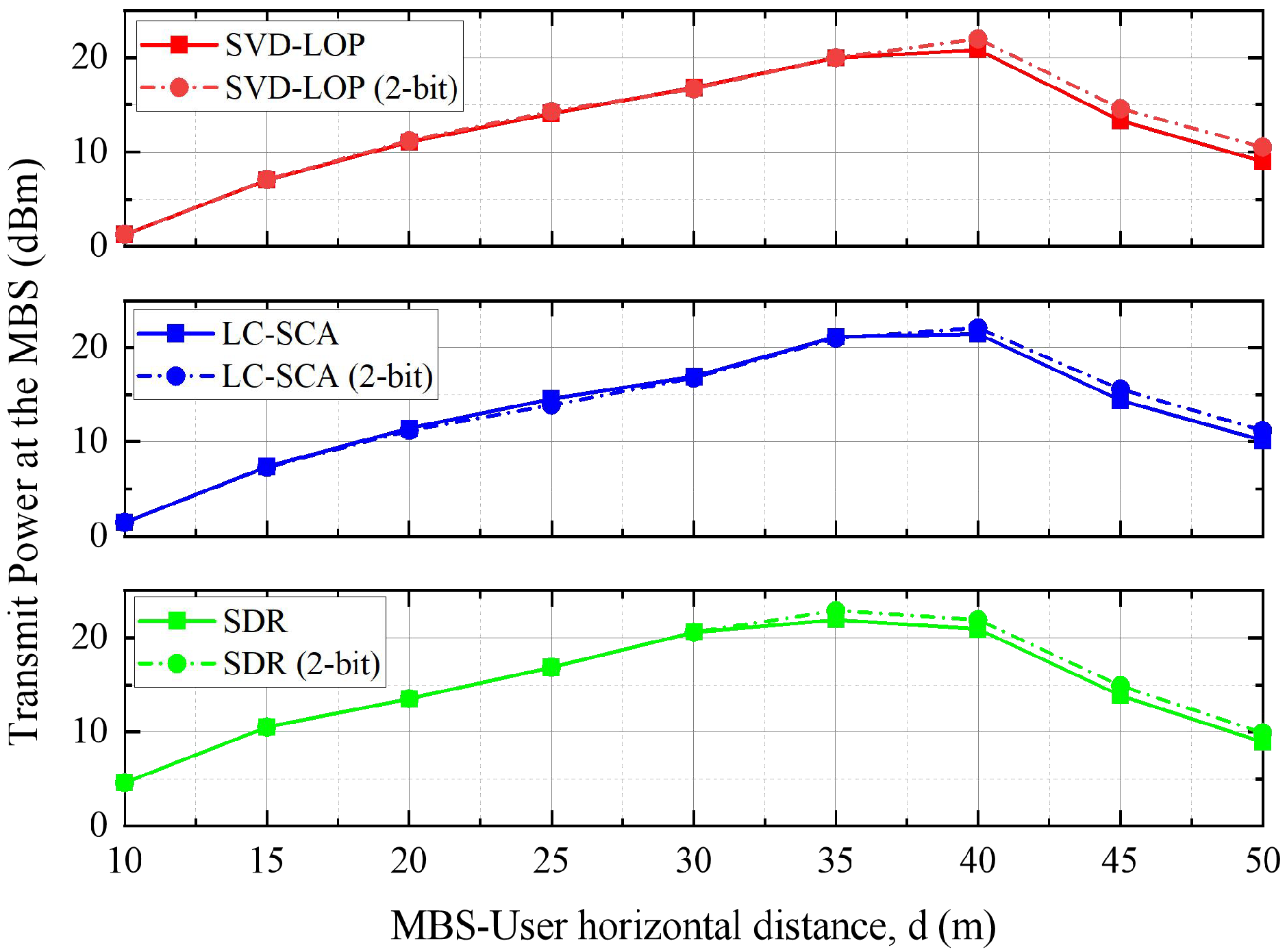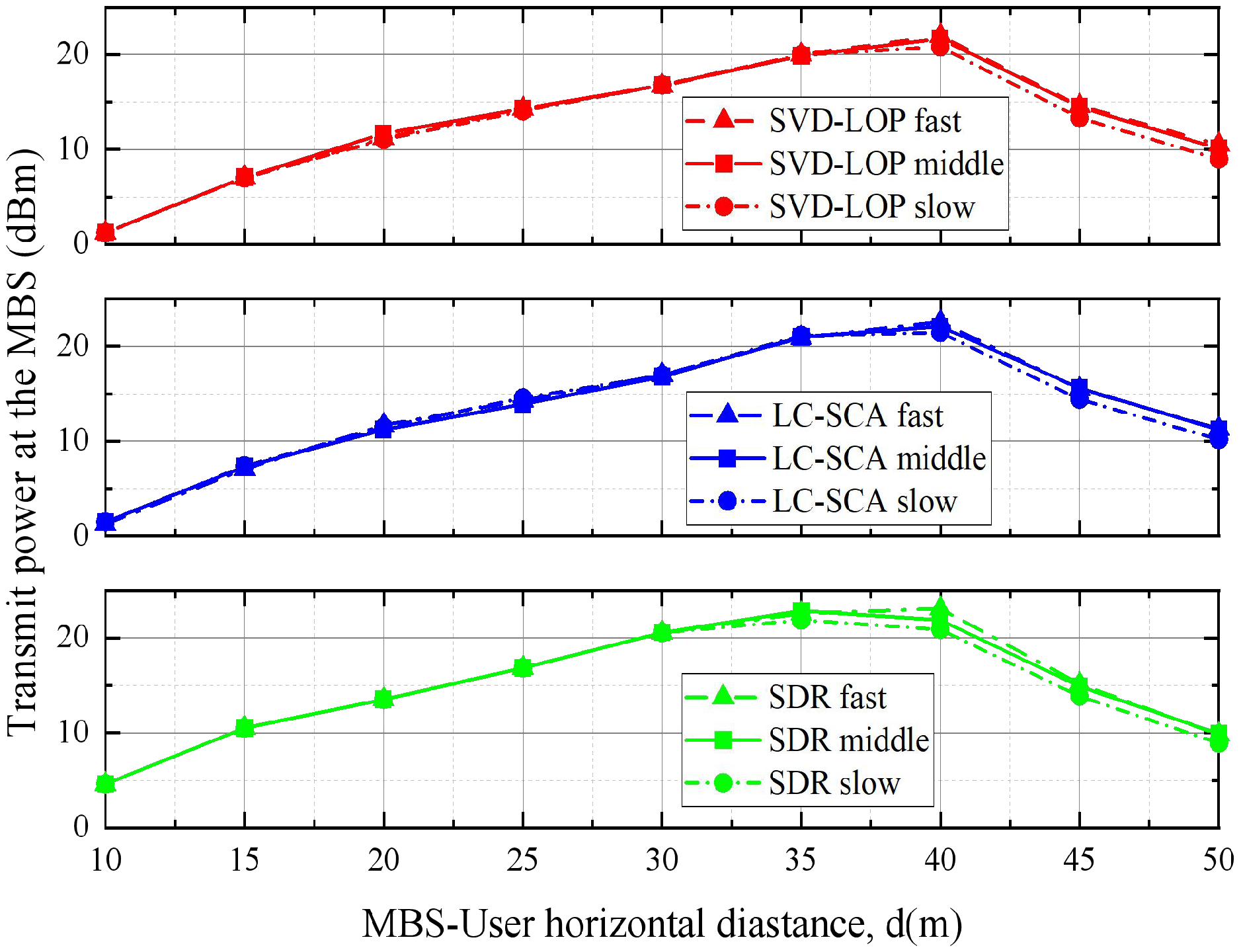1. Introduction
The complex structure and environment in the coal mine tunnel result in path loss, absorption attenuation, and multi-path effects during signal propagation, which significantly degrades wireless transmission reliability and consequently impairs the data collections and command interactions for IoT devices [
1]. To alleviate signal attenuation, increasing transmit power is a common approach. However, for the coal mine wireless communication system, the explosion-proof safety transmission power threshold is stipulated to not exceed 6 W (i.e.,
) due to the fact that higher-power radio waves may ignite gas and coal dust [
2]. In addition, most IoT devices deployed in underground coal mines, such as monitoring terminals, are battery-powered and highly energy-constrained [
3]. Therefore, transmit power optimization becomes essential to address these requirements. The beamforming technology is a critical approach for achieving the minimum transmit power (MiniPower) by adjusting the phase and amplitude of the antenna array at the transmitter to make the signal energy add coherently for a particular receive direction [
4]. However, due to the limitations of the base station (BS) deployment locations and the complex wireless propagation characteristics in coal mine tunnels, the beam from the transmitter is difficult to reach the desired target location [
5]. Therefore, how to minimize the transmit power while ensuring communication quality has become a challenging problem for wireless communication systems in coal mines.
As one of the promising technologies for sixth-generation (6G) wireless networks, an intelligent reflecting surface (IRS) composed of a large number of low-cost passive reflecting elements can offer advantages such as low energy consumption, low cost, and ease of deployment [
6,
7]. Herein, IRS passive beamforming technology can achieve the directional signal transmission through the control of passive reflection units. Specifically, each IRS passive element can independently reflect the incident signal by controlling its amplitude and/or phase to realize coherent superposition of the reflected signals in the target direction, which can overcome the limitations of traditional beamforming that rely on a finite number of antennas. To ensure the minimal transmit power, the prevailing approaches for MiniPower problems mainly focus on the joint optimization of beamforming at the BS and IRS phase shifts in IRS-assisted communication systems [
8,
9,
10,
11,
12,
13,
14,
15].
In [
8], the MiniPower problem in IRS-aided single-user wireless communication systems can be solved by applying the semidefinite relaxation (SDR) technique and obtaining a high-quality approximate solution. They also proposed a two-stage algorithm and alternating optimization (AO) algorithm to obtain suboptimal solutions that can offer different trade-offs between performance and complexity for the multiuser scenario. In [
9], IRS-assisted multiple-input multiple-output (MIMO) systems are further investigated, which demonstrates that the introduction of IRSs can reduce the transmit power to less than
compared by the conventional systems without IRS while maintaining communication quality. For IRS-assisted non-orthogonal multiple access (NOMA) systems, a closed-form expression of IRS phase shifts can be derived by a low-complexity beamforming design method based on Karush–Kuhn–Tucker (KKT) optimal conditions in [
10]. Moreover, the MiniPower problem also appears in other scenarios. In IRS-assisted uplink Internet of Things (IoT) networks, the Riemannian manifold-based alternating optimization (RM-AO) algorithm has been employed to minimize users’ uplink transmit power by jointly optimizing IRS phase shifts, and base stations (BSs) receive beamforming [
11]. In [
12], for IRS-assisted physical-layer broadcast communication systems, an alternating optimization algorithm based on SDR and successive convex approximation (SCA) is adopted to optimize and minimize the BS’s transmit power while satisfying the QoS constraints of each piece of mobile equipment (ME). Their works demonstrated joining traditional beamforming and IRS passive beamforming technology to achieve better network resource allocation on the roadbed. Moreover, a large amount of work [
16,
17,
18] has verified that the passive operation, low power consumption, ease of deployment, and cost-effectiveness of the IRS make it particularly suitable for coal mine tunnels where there are strict safety regulations for electrical equipment. Nevertheless, the application of IRS passive beamforming technology still poses great challenges for the complex environment and stringent power constraints in coal mines.
In this paper, we propose a singular value decomposition-based Lagrangian optimization (SVD-LOP) algorithm to minimize the transmit power at the mining base station (MBS) for IRS-assisted coal mine wireless communication systems. Firstly, considering the characteristics of rough tunnels and dense coal dust scatterers, we propose a three-dimensional twin cluster geometry-based stochastic model (3D-TCGBSM) system model to characterize a rectangular coal mine tunnel communication assisted by IRS. On this basis, a non-convex MiniPower problem constrained by user SNR target and IRS phase shifts is formulated. To solve this problem, we propose an SVD-LOP algorithm by performing the SVD and introducing the Lagrange multipliers to obtain the optimal solution. To reduce computational complexity, we further propose a low-complexity successive convex approximation (LC-SCA) algorithm via the first-order Taylor formula and polarization processing to successively approximate the objective function and obtain the suboptimal solution. Simulation results demonstrate that the proposed SVD-LOP algorithm achieves superior power optimization performance compared to SDR before peak power while maintaining comparable performance thereafter. The proposed LC-SCA algorithm also outperforms SDR before the peak and then slightly degrades after the peak. Furthermore, both proposed algorithms exhibit significantly lower computational complexity, for SVD-LOP and for LC-SCA, compared to the complexity of the SDR algorithm. In addition, the proposed algorithms consistently outperform SDR under varying user SNR targets and different tunnel roughness scenarios.
4. Simulation Results
In this section, simulations are conducted to verify the effectiveness of the proposed 3D-TCGBSM system model and algorithms. A typical coal mine tunnel with
in width and
in height is considered. A coordinate system with MBS as the origin is established, where IRS is deployed at the top of this tunnel
along the positive
y-axis from MBS. Users move within the tunnel between MBS and IRS, and the horizontal distance from MBS to user is defined as
d. In the coal mine communication system, each randomly moving cluster is set to contain 50 rays, and each channel-corresponding double cluster has an equal survival probability. According to the definition of the Markov birth/death process, the birth/death process is determined by the cluster generation rate and recombination rate (
) [
19]. To characterize the channel response characteristics in underground mines, we set the frequency variable
f to
, which is a common commercial operating frequency in coal mine wireless communication systems [
17]. In addition, the key parameters are shown in
Table 2.
To verify the effectiveness of the proposed IRS-assisted 3D-TCGBSM model, we performed a sensitivity analysis of channel capacity under different tunnel roughness levels
. Three representative roughness values were considered: 0 (perfectly smooth tunnel),
(moderately rough), and
(very rough).
Figure 5 illustrates the simulation results obtained from our proposed model across a range of SNR values. The results show that, as
increases, the overall channel capacity decreases due to stronger multipath scattering and attenuation; however, the IRS-assisted 3D-TCGBSM model consistently achieves higher capacity than the conventional GBSM reported in [
24], particularly under high roughness conditions. For example, when
and
, the proposed model achieves a capacity of around
, which is significantly higher than the 7–
reported for the conventional GBSM in [
25]. These results confirm that the proposed model not only preserves accurate characterization of the coal mine environment but also enhances channel capacity by leveraging IRS-assisted passive beamforming.
For the effectiveness of the proposed algorithms, we investigated the transmit powers at MBS under different schemes, as shown in
Figure 6. The parameter settings are user SNR
and the roughness of the mine tunnel
. It can be observed that for the scheme without IRS, the transmit power increases rapidly as the user moves away from the MBS, while for the IRS-assisted schemes, the transmit power first increases and then decreases as the user approaches the IRS. This demonstrates that deploying IRS can effectively reduce transmit power and expand signal coverage without installing additional active relays in the coal mine tunnels. However, the IRS random phase scheme shows almost no significant improvement compared to the proposed SVD-LOP, LC-SCA, and SDR algorithms, which highlights the necessity of IRS phase optimization. For these three algorithms, when
, the transmit power of the proposed SVD-LOP and LC-SCA algorithms is lower than that of the SDR algorithm. This is because the probability that the SDR algorithm finds an QoS-satisfying vector via Gaussian randomization is significantly reduced in dynamically varying mine channel responses, whereas the SVD-LOP algorithm, based on channel matrix decomposition, offers better adaptability to real-time channel variations. When
, the three algorithms exhibit nearly identical performance. Nevertheless, the computational complexity of the SDR algorithm is as high as
, while that of the proposed SVD-LOP and LC-SCA algorithms is
and
, respectively. Overall, these results indicate that the proposed algorithms can achieve comparable performance to SDR with significantly lower computational cost.
Building on this performance and complexity analysis, it is important to emphasize that, after IRS phase optimization, the required transmit power remains far below the explosion-proof power threshold of
(i.e.,
). As shown in
Figure 6, the transmit power of the system without IRS approaches this threshold at around
, posing a potential safety concern. In contrast, the proposed SVD-LOP and LC-SCA algorithms maintain a substantial safety margin even at
. Specifically, the SVD-LOP algorithm achieves a transmit power of
, representing a reduction of
compared to the safety threshold, while the LC-SCA algorithm achieves
, corresponding to a reduction of
. This clearly demonstrates that the optimized IRS phase configuration keeps the transmit power well below the critical limit, thereby ensuring intrinsic safety in underground environments.
Table 3 summarizes the transmit power (i.e.,
) at distances
d and their corresponding margins (i.e.,
) relative to the
explosion threshold. Therefore, the proposed algorithms achieve effective power optimization with low complexity, enhancing coverage and ensuring reliable coal mine communications.
Next, we investigate the impact of different roughness levels
of coal mine tunnels on the performance of the proposed SVD-LOP and LC-SCA algorithms and SDR algorithm, as shown in
Figure 7. We set three typical roughness values: 0,
, and
. Simulation shows that as
increases, transmit power at MBS also increases, as expected. However, regardless of the roughness, the proposed SVD-LOP and LC-SCA algorithms consistently achieve lower transmit power than the SDR algorithm, which validates the effectiveness of the SVD-LOP and LC-SCA algorithms in coal mine scenarios.
We validate the convergence of the proposed SVD-LOP and LC-SCA algorithms and SDR algorithm under different SNRs (i.e.,
,
, and
), as shown in
Figure 8. Set
and
. It can be seen that the convergence speed of the proposed SVD-LOP and LC-SCA algorithms is faster than that of the SDR algorithm at
. In addition, for larger
values, the performance improvement of the proposed SVD-LOP and LC-SCA algorithms increases compared to the SDR algorithm. Therefore, the SVD-LOP and LC-SCA algorithms exhibit better adaptability to the channel response in coal mine tunnel communication.
In the following, we compare the transmit power optimization of schemes with respect to the number of IRS reflecting elements at
and
, as shown in
Figure 9. Set
and
. At
, it can be clearly observed that the proposed SVD-LOP and LC-SCA algorithms and SDR algorithm exhibit a clear trend of monotonically decreasing transmit power as the number of IRS reflecting elements increases. It is worth noting that the SDR algorithm exhibits the highest transmit power consumption among the three algorithms. Specifically, when
and
, the transmit power of the SVD-LOP algorithm is
, while the LC-SCA algorithm exhibits a transmit power of
, and the SDR algorithm results in
. When
, the SVD-LOP algorithm reduces its transmit power to
, a decrease of
compared to
; the LC-SCA algorithm achieves
, a reduction of
; the SDR algorithm’s transmit power decreases to
, a reduction of
. As the number of reflecting elements increases, the transmit power steadily decreases and eventually stabilizes, consistently remaining well below the explosion-proof safety threshold of
. At
, as the number of IRS reflecting elements increases, the performance of the SVD-LOP and SDR algorithms becomes nearly identical, while the performance gap between LC-SCA and the other two schemes continues to narrow, with all three algorithms showing significantly lower transmit power than the threshold. Although the SDR algorithm has a certain capability in optimizing transmit power, its computational complexity reaches
. In contrast, the proposed SVD-LOP and LC-SCA algorithms have significantly lower computational complexity, making them more suitable for dynamic and resource constrained environments such as coal mine communication.
We illustrate the relationship between achievable rate and the number of IRS reflecting elements under a fixed transmit power, as shown in
Figure 10. Set
and
, and fixed transmit power is
, lower than the threshold. As expected, the achievable rate increases steadily with the number of IRS reflecting elements. It is obvious that the SVD-LOP algorithm consistently achieves the highest achievable rate, demonstrating its effectiveness in leveraging IRS phase-shift gains through channel matrix decomposition. The LC-SCA algorithm achieves comparable performance and closely follows SVD-LOP in most cases, which indicates its ability to maintain rate performance and significantly reduce computational complexity. In contrast, the SDR algorithm exhibits inferior performance. Simulation shows the proposed SVD-LOP and LC-SCA algorithms can optimize the achievable rate with low complexity, which makes them suitable for resource-limited environments such as coal mine communication.
In underground coal mine wireless communication scenarios, system performance is affected by several non-ideal factors, including IRS phase noise induced by hardware imperfections, phase quantization errors caused by discrete phase shifters, and the time-varying characteristics of the channel due to dynamic scatterers such as moving coal dust. To evaluate the robustness of the proposed algorithms under these practical impairments, we conducted additional simulations and analyses. First, in the presence of phase noise [
24], the IRS reflection matrix can be modeled as
where
denotes the amplitude coefficient (
) ans
the phase noise following the distribution of
. After introducing the same phase noise
, we compare the performance of the proposed SVD-LOP and LC-SCA algorithms with the SDR algorithm, as shown in
Figure 11. It indicates that the MBS transmit power slightly increases under the same phase noise condition. However, both the proposed SVD-LOP and LC-SCA algorithms consistently outperform the SDR algorithm in the presence of identical phase noise. The peak transmit power under phase noise is
for SVD-LOP,
for LC-SCA, and
for SDR. These results clearly demonstrate that, compared with the benchmark algorithm, the proposed methods exhibit superior robustness in the presence of phase noise and remain well below the explosion-proof safety threshold.
Then, with regard to the IRS phase quantization described in [
11,
26,
27,
28], we consider practical discrete phase shifts, that is,
, where
is the number of quantized levels when
b-bit quantization is used. Specifically, we choose 2-bit quantization and randomly generate
, as shown in
Figure 12. It can be observed that the minimization transmit power will increase slightly, but under the same quantization error, the proposed SVD-LOP and LC-SCA algorithms always outperform the SDR algorithm. The simulation results show, to some extent, that the proposed SVD-LOP and LC-SCA algorithms have better robustness.
Finally, the 3D-TCGBSM model in our channel modeling characterizes temporal variations based on the generation and disappearance of clusters (Markov birth–death process) combined with tunnel structural features and environmental factors such as scattering surface roughness [
19]. This framework captures the random appearance and disappearance of scattering clusters caused by coal dust in coal mine tunnels, which leads to fluctuations in the equivalent channel gain and phase over time. By explicitly introducing parameters such as the cluster generation rate
and recombination rate
into the channel modeling, we are able to directly represent time-varying processes with different speeds. Specifically, we considered three representative scenarios: “slow” (
), “medium” (
), and “fast” (
), corresponding to channels with slow, moderate, and fast cluster dynamics, respectively, as shown in
Figure 13. The simulation results demonstrate that under all three cluster variation rates, the proposed SVD-LOP and LC-SCA algorithms consistently maintain significant power optimization advantages.
In summary, the supplementary simulations considering IRS phase noise, quantization errors, and time-varying channels demonstrate that the proposed SVD-LOP and LC-SCA algorithms maintain stable power optimization performance under practical non-ideal conditions, with the transmit power consistently remaining well below the explosion-proof threshold in coal mines. Compared with the SDR algorithm, the proposed methods exhibit stronger robustness to these impairments, providing a solid foundation for their practical deployment in complex underground coal mine wireless communication systems.
